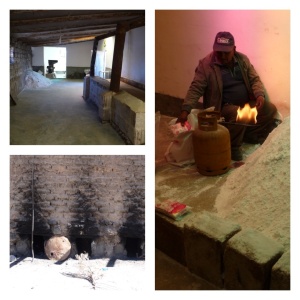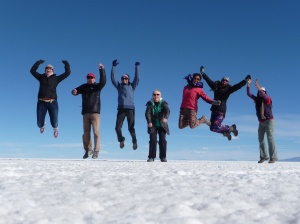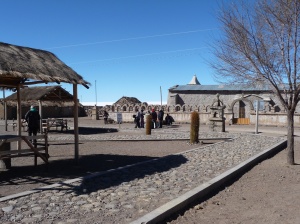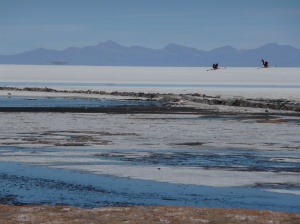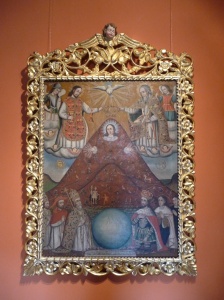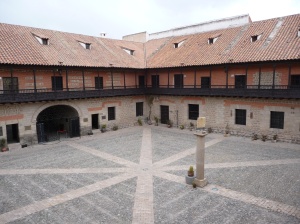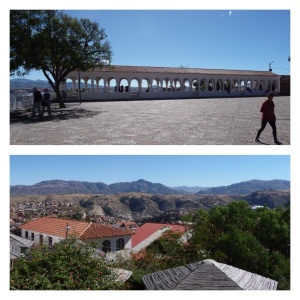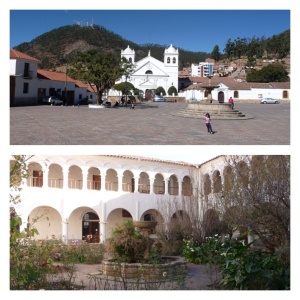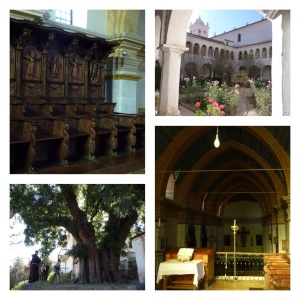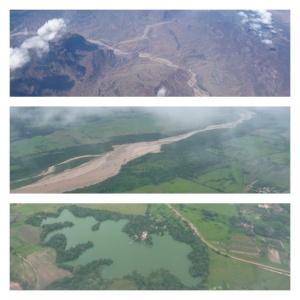The border crossing between Peru and Bolivia was a bit of a laugh. We were travelling by public bus so everyone on the bus were let off at the Peru immigration office to then walk across the bridge to the Bolivian immigration office. We couldn’t work out whether the street vendors on the bridge were Peruvian or Bolivian. We were then collected on the other side of the bridge to continue our journey to La Paz.
The countryside didn’t disappoint with us running parallel with the snow capped mountains and Lake Titicaca a good part of the way.
We arrived into the bustling city of La Paz – an attractive hilly city (just what you need at 4000m above sea level).
The main industry of Bolivia is mining – silver, copper, gold and mercury.
A walk around the city saw us wander past the San Francisco church, a dominant church at the base of the witches markets (the markets selling everything from baby alpaca knits to llama foetuses). The main plaza, Plaza de Armas, contained a statue of Murilla (the leader of Bolivia’s independence) and hundreds of pidgeons and was surrounded by the Cathedral and the presidential palace. Due to the population size of the city and the extent of political decision making made in La Paz, it is considered the administrative capital of Bolivia (but is not recognised as the capital in Bolivia’s constitution).
That evening we had a lovely farewell dinner as the majority of the group were heading home or onto new travel adventures over coming days. Cristina convinced me to venture out with her to a ‘great’ club that had been recommended to her. Was a bit of a disappointment to us as the bar was full of very young, drunk and smoking backpackers. We decided instead to head over to the Hard Rock Cafe – yes even Bolivia has one!
The next day was spent sorting out my Paraguay visa – a long drawn out process that took most of the day but left me enough time for a spot of shopping at the witches markets. Note to family – you’ll be pleased to know that I opted for handicrafts rather than the foetuses and other witchy potions!
Then it was game on – Death Road. I had signed up for it with Megan, Rosie, Isabella and Finn. A 64km ride with 25kms paved and the remainder unpaved (which was actually the death road). The road started to be built before the end of the war between Paraguay and Bolivia. The Bolivians brought the Paraguay prisoners up to finish the road after the war.
Suited up we got our instructions on how to use the bikes (particularly on the rocky corners) and then did our ritual to Pachamama – a splash of the 96% alcohol on the earth, a splash on the front wheel and then a nip for each of us – certainly took our breath away but shook out some of the nerves.
And then we were off from 4700m above sea level – it was freezing – as evidenced by the ice on the mountainside as we passed (thankfully none on the road). As we approached the drug control point our guide, Raf, advised that if we were carrying drugs now was the time to “pop it or drop it”.
We got a taster of what was ahead when we took a dirt road to avoid a tunnel. Not having done any serious mount biking in my time and encountering serious loose gravel, rocks and washouts, it was at this point that I seriously questioned why I had signed up (let alone paid) to do this ride. Gave myself a Chopper Reed talking to and pushed on.
The Death Road was very rocky and narrow in places with constant blind corners but had some lovely little waterfalls that we rode through. We were warned not to look at the drop offs as it would likely scare and distract us. By the time we reached the last part of the ride we had all gained heaps of confidence on our bikes so enjoyed the view of the coca fields. Amazing how much your head and hands can hurt after hours of riding on corrugated roads.
Not satisfied with the challenge of the death road we signed up for some more adventure in the form of zip lining across some of the ravines – three lines covering more than one and a half kilometres. I hadn’t done it before and really enjoyed the sensation of soaring through the air. Perhaps I’ll have to try the paragliding in Rio?
The lunch spot was at an animal rescue centre which had lovely birds flying in and out of the Centre and resident spider monkeys and tortoises.
We then drove back up Death Road in our van – it took nearly two hours to drive it and it was just as scary in a car. Looking down over the fog that had rolled in we were all happy when we were off the road.
Farewelled Megan that evening, which was sad. We’d been great travel mates with lots in common and sharing our Aussie sense of humour – would have been great if she had of also been going through to Rio but alas her partner and work were calling her home. No doubt we’d meet up again in Sydney sometime.
We were now down to six with Cristina. I was looking forward to ease of travelling in a smaller group.
Before leaving La Paz I thought it a good idea to buy some fruit for the journey. During my shopping trip I went to help a woman who I thought had fallen into a gutter only to find tgat she was purposely holding out the layers of her skirt so they wouldn’t get wet while she peed! Another memory etched into the brain.
Off we went to Oruro on a bus and then boarded a train for Uyuni. We almost missed the train trying to get a meal in the town of Oruro. From this experience I concluded that in Bolivia, despite what they advertise, there is no such thing as fast food.
It was a pretty rickety and slow old train ride. We arrived into Uyuni at 2:15am and so headed straight to the hotel for a sleep before our overnight trip to the Salar de Uyuni (salt plains).
The first stop of our overnight trip was the train cemetery. Apparently all the trains were brought across from the UK and were used in Bolivia as far back as 1890. They were taken to this area for repairs until eventually they stayed! Unfortunately everyone is so poor they are now having trouble with people pinching the metal to on-sell, which may see this little tourist attraction disappear eventually.
One of the main industries in the area (aside from salt processing) is the growing of quinoa, which is hard to believe in such an arid looking place.
The roofs had us intrigued with their channels of mud – seems it was there to hold the roof sheets down during the ferocious winds the area receives.
We were back in Vicuña territory; nice to see them out and about again.
The next stop was Colchani, a town of salt production. We were shown through a building used to undertake the process. Twenty five thousand tonnes are extracted from the Salar de Uyuni per year with 25 tonnes being produced in Colchani. They are the largest salt plains in the world but interestingly the salt is produced for use in Bolivia only. It’s estimated that there are 10 billion tonnes of salt in the plains.
We were then onto the Salar itself. The salt is up to 25-30 metres deep in some places and is as vast as the eye can see. After lunch in a building made of salt we headed out for some photos in this amazing landscape. It was no surprise when we were informed that the Dakar rally would be coming to town in 2014 – seemed just the right scene for that race.
Incahuasi Island was the next stop with its island of cacti. There were some as high as 1200m – they grow a centimetre every year.
Our hotel for the night was made of salt. It was cold at one degree but thankfully not as cold as the minus 10 we had prepared for – cold enough when there’s no heating.
We drove across the salt plains toward Volcan Thunupa. The vastness of the plains were quite incredible. There are no roads across the plains so our driver was skilfully lining up the rock formations to get to our desired destination – you can get caught on the wrong side of them if you aren’t careful as the salt creates an optical illusion. I was pleased we were travelling in two cars in case there were any mechanical issues.
We drove through the little town of Coqueza (25 families), which had been celebrating its annual anniversary (created in 1990) for the last two days – hence they were pretty inebriated.
The high viewpoint behind the town was lovely and gave us access to a cave in which the locals had placed mummies that had been found in the area in the last 40 years. I had my doubts they were actually mummies believing they were more likely just bodies well preserved from the cold.
The lunch spot was lovely with us joining flamingoes who were lunching in a shallow lagoon surrounding the village and volcano. It took us another two and a half hours to drive back to Uyuni – spotting black dots in the distance which were other 4WD vehicles on the Salar.
On arrival back into Uyuni we heard crackers going off. On enquiries we found out they were from the families of people who were awaiting advice on their sentence for criminal convictions. It appears they have a judicial system based on a reverse onus of proof and the non-appealable decisions are made by the authorities rather than any judicial member. Good place not to live!
The bus trip to Potosi the following morning had us passing very arid land. I’ll remember Potosi for its diesel fumes – not what you want when your breathing is already challenged at 4060m. The town is pretty hilly with Cerro Rico dominating the landscape reminding all of the surrounding mines.
Potosi is a town of miners (16 thousand of them). We got to see them first hand with a tour through a mine that has a total workforce of 500. Most mines are now run as cooperatives with the workers as a means of reducing the exploitation of the workers.
Bang, bang, bang – that’s the sound of my hardhat hitting the headers in the tunnels. The conditions were atrocious with the miners surviving on coca leaves to suppress their appetite and to help them manage fatigue caused at altitude. They also had a theory that chewing it helped filter dust they were forced to breathe – ludicrous. Everything was done manually from hauling up rocks by winches to pushing trolleys full of rocks.
I didn’t feel safe in the mine tunnels – light only from the torches on our hard hats, timber headers busted in more places than I like to think about and the sound of leaks from the drills’ compressed air lines all along the tunnels. We passed a vigil to the god Tio; meant to keep away the evil underground spirits and help them strike silver and get through the day.
The buildings of Potosi were quite lovely (a great contrast to the mines) – highlighting the wealth of this town at the time of the Spanish colonists; on the back of the natives and african slaves! Carved stone was present on public, religious and private homes. A lot of the properties had changed from public buildings (hospitals, etc) to private homes and then back to public buildings over time.
I headed along to check out the largest building from colonial times, which was the Casa de Modena – the mint. Potosi was very cold, still being very high, but thankfully the guidebook had warned me that the mint gets extremely cold so I was dressed for the occasion. Our tour guide was great, showing us through the lovely collection of art (donated by citizens when the museum opened) including some of the local artists such as Melchor Peréz Holguín. I particularly liked the painting of the virgin mary in the shape of Cerro Rico with a range of adornments blending the former native beliefs with Catholicism – the Spanish were masterful in their marketing of Catholicism to people with such deep seated alternative religions.
Of course the coin collection was a bit of a feature with them having minted their coins until early 1900s when nickel became the preferred metal for coins. It is quite ironic that after supplying mint around the world for 450 years (for the Spanish) Bolivia now obtains its currency from other countries! The Potosi symbol used on its currency (like a maker’s mark) is still used today on some US currency. It was interesting to see the transition used for the production – went from mule driven silver rolling machines to steam driven machines to finally electric machines. A number of the machines had been designed by Leonardo de Vinci. The building itself is quite a work of art – beautiful block and rustic stone walls with a number of alleys and courtyards.
First time I had actually thought it would be good to be home; I was in a cold and miserable city. A call from my congregated family that night certainly lifted my spirits. I was up and ready for more adventures.
The next day we were on a promise – Sucre (constitutional capital of Bolivia) – lower ground and warmer! The bus trip had its usual surprises, this time a busker! It just won’t be the same catching a bus at home and not having vendors walk the aisles of the bus selling anything from roast chicken, boiled eggs, plantain chips and ice creams to drinks sold in packages that resemble condoms!
The trip was reminiscent of home as we passed hills dotted with gum trees – Australia has certainly left its mark on South America.
I had another “must be time for a trip to the hairdresser” experience, this time at the Sucre post office. The guy at the post office was obviously a bit bored when I arrived in with my package – he invited me around to his side of the counter to sort it out for me. We then proceeded to get things underway with his very limited English and my very limited Spanish. He asked me to wait while he went to photocopy my passport. At that moment a stream of customers chose to rock up to ‘my glass faced counter’ asking for various services. The first lot (Spanish speaking) were a little confused when I let them know in Spanish that I couldn’t understand them. The second lot were Scandinavian and were quite amused when I let them know I didn’t work there and was waiting for the postal officer to return! Lovely guy – just hope my package arrives home ok.
The visit to the Arte Indigena Museo rewarded us with a great display of local textiles. The Andean technique was more than 3000 years old in some cases. In pre-Colombian times the weaving was all done by the women on traditional weaving looms. The men began weaving once the Spanish pedestal looms were available (much less labour intensive) but they were unable to achieve the beautifully detailed designs achieved by the women. The exhibitions of costumes and dress ornaments were excellent. I really liked the horn tubes to hold hallucinogenic substances – these Andeans certainly liked their drugs!
The afternoon was spent dodging the cars that had come to town for the annual rally car event. The city was abuzz with excitement but unfortunately it meant most of the museums were closed – not to mention it was hazardous getting across the road of our hotel which seemed to be the main straight for the race. I headed up to La Recoleta Convent and the adjoining viewpoint of Sucre with Rosie and Isabella. We were shown a spot in the convent where a former president had been killed as well as a one thousand year old indigenous tree (cedar) – not sure who was keeping the log given the convent hadn’t been there that long.
I was then onto bigger and braver things – a trip to a hairdresser for a touch up of my naturally (?!?!? ) blonde hair in a town where 99.999% of the population have black or chocolate brown hair. Success – I think they had five people on it at one time; well worth the US$20 it cost!
The next day I should have been issued a pass to the nearest psychiatric hospital as I signed up for a trek back up at altitude – that’s how maddening the roar of the rally cars zooming around the city were.
It was a lovely walk along an inca trail from the Chataquila plaza. Our lunch spot was by a dry riverbed surrounded by gum trees – felt like we could have been in Australia! We then ventured onto Marawa, which was a very small town built in a crater (they’re still not sure what caused the crater but the swirls on the surrounding hills had people guessing it was from a meteorite). Then it was back into Sucre, which had returned to being the lovely university city that it is.
The next day we were back onto a plane, this time for our last stop in Bolivia – Santa Cruz. Santa Cruz is renowned for its subtropical climate but it’s also very windy. As soon as we arrived we noticed the men were noticeably taller – turns out they’re Brazilians choosing the cheaper lifestyle of Bolivia. There were plenty of Mennonites around town also – presumably from the States or Canada – enjoying the very fertile farming land.
There really wasn’t much to see or do in Santa Cruz just a bit of down time before our border crossing into Brazil. I did manage to catch The Great Gatsby (in English!) at the cinema with some tour buddies – another good one by Baz!
Our last night in Bolivia was spent on an overnight train to the Brazilian border. We were all snacked up and ready to finish our books before our arrival at 7am for what we had been warned would be a lengthy border crossing!



























